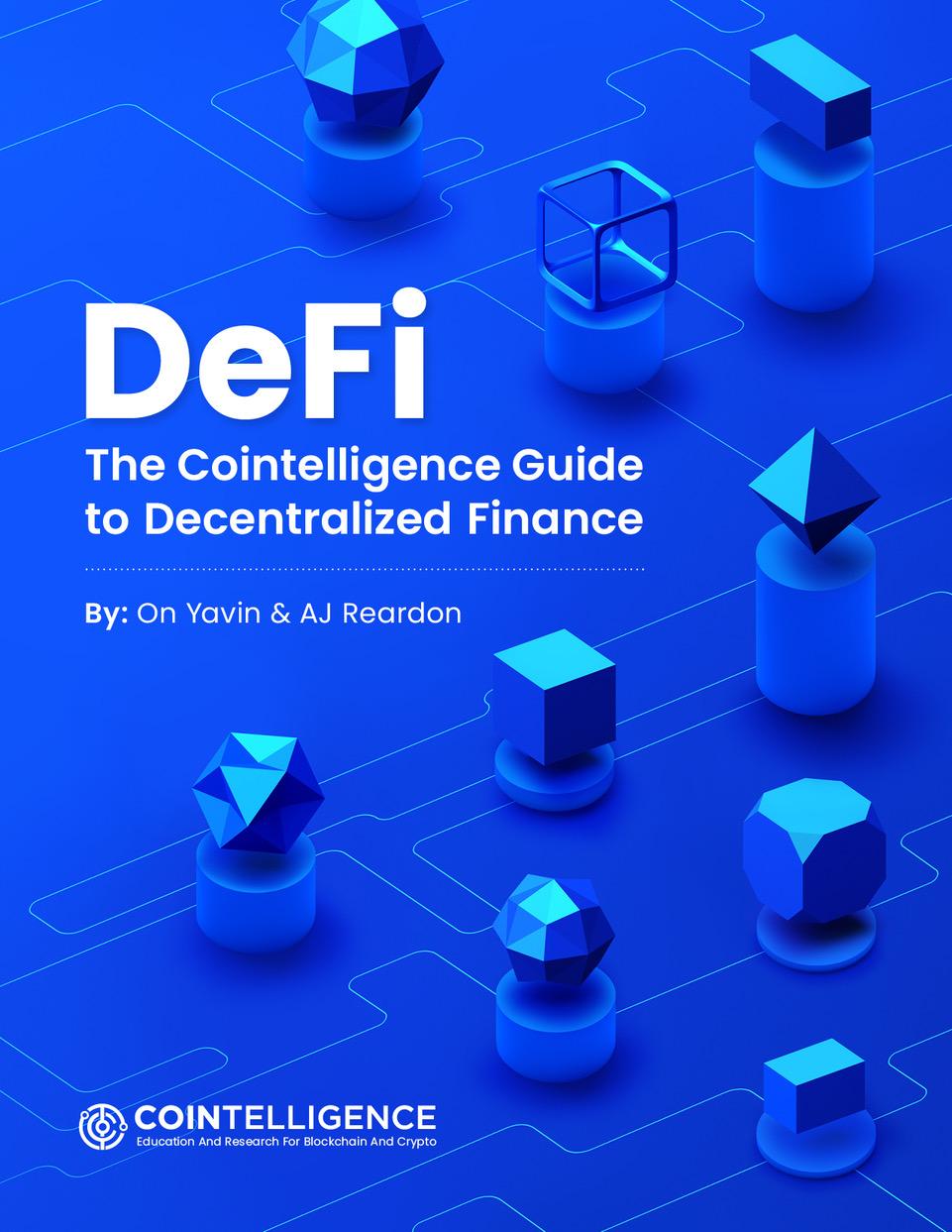We’re excited to announce that we have published our first-ever book. The Cointelligence Guide to Decentralized Finance (DeFi) looks at the current state of the DeFi industry, and considers the exciting possibilities for the future of this field.
Written by Cointelligence CEO On Yavin and Chief Editor AJ Reardon, this book continues Cointelligence’s tradition of producing well-researched educational guides that provide a brand-neutral overview of the subject.
Learn all about DeFi
The Cointelligence Guide to Decentralized Finance (DeFi) will not only teach you about DeFi, but it also explains foundational concepts necessary to understand DeFi. Readers will find an overview of Ethereum, smart contracts, and oracle networks to help them understand how DeFi dapps work. They’ll find a history of the evolution of digital finance, showing how we arrived where we are today. And they will learn about DeFi solutions for payments, exchanges, insurance, and more.
Because this field is growing and changing at an incredible pace, we’ll be updating the book regularly with the newest developments and latest stats on the DeFi industry.
This book was written for anyone who is interested in DeFi, including but not limited to: students, educators, developers, investors, newcomers to the crypto industry, and anyone working in the financial services, high tech, law, and real estate industries in any capacity, whether at a startup or a long-established institution. You'll learn the answers to questions such as what is DeFi, how do I get started with it, and is it safe?
Table of contents
Chapter 1: DeFi: What and Why?
Chapter 2: A Brief History of the Blockchain Revolution and DeFi
Chapter 3: Blockchain Basics
Chapter 4: Different Kinds of Tokens
Chapter 5: How Does DeFi Work?
Chapter 6: Payments
Chapter 7: Lending and Borrowing
Chapter 8: Insurance
Chapter 9: Non-Custodial Exchanges
Chapter 10: Risks of DeFi
Chapter 11: Banking the Unbanked
Chapter 12: Quick Answers
Examples of Decentralized Projects

An Excerpt from Chapter 1 - DeFi: What and Why?
The decentralized finance movement began gaining traction in the aftermath of the financial crisis of 2008. Although some of the foundational concepts were developed earlier and there had been other attempts to create a digital currency predating that event, the events of 2008 were really the catalyst for innovators to finally try to do something about their growing displeasure with the traditional financial industry.
The cryptocurrency revolution was kicked off when Satoshi Nakomoto (commonly referred to as just “Satoshi” in the crypto community) released their Bitcoin whitepaper in October 2008, which proposed the creation of a decentralized digital currency. From that idea, the entire blockchain and cryptocurrency industry was spawned, and the idea of decentralized finance along with it.
The problem with cryptocurrency is that the various currencies on their own only address one facet of finance: the storage and transfer of funds. While that is an important process that most of us deal with on a daily basis, it’s also only the most basic function of money. To have a truly decentralized financial world, you need to also give people the opportunity to invest, lend, borrow, and earn interest off of their assets, among other things, in a decentralized manner.
In response to this growing demand, an entire array of decentralized financial options have been created in order to allow people to take full advantage of their cryptocurrency. The majority of these financial tools take the form of decentralized apps, more commonly known as dapps.
Build Your Financial Portfolio with Modular Dapps
DeFi products can be mixed and matched due to their modular nature. This allows you to create an interconnected collection of the services that you need and want, ensuring the ability to choose the best provider for each service. This is in stark contrast to traditional financial services, where you either rely on one provider for everything, or have separate accounts with a retail bank, an investment bank, a stock broker, and more - none of whom make it easy to transfer your funds between them.
DeFi dapps are built on a blockchain (more on that in Chapter 3), and are programmed to be compatible with each other. The programmability of the assets and apps means that, regardless of whether or not they are built on the same blockchain, all of your funds can be easily transferred from one DeFi platform to another, based on what you currently need or want to do with your assets. For example, funds from your Ethereum wallet can easily be transferred for use in different financial instruments in the DeFi ecosystem.
Why Does Decentralization Matter?
Why has decentralization become such a rallying cry in recent years? To put it simply, people want more control over their assets and access to a wider variety of financial instruments, while avoiding dependence on centralized financial authorities.
Other forms of currency are currently governed by a collection of overlapping centralized authorities. For starters, the fiat currency of your country is controlled by the country’s national government. However, there may also be local regulations about money based on your state/province, county, or city - for instance, some municipalities have laws to protect people from predatory lending. And each institution that you use to manage your money has its own rules as well. Banks have minimum account balances, daily withdrawal caps, and limits on how many transfers you may make from savings in a given period. Credit card companies can choose to cancel your card if they see suspicious activity, or if the system’s algorithms think they detect even the possibility of fraud. In fact, banks and credit cards can freeze your accounts at inconvenient moments for no apparent reason, simply because something has triggered their system to believe they could stand to lose money. Investment opportunities can require a buy-in so high that they exclude all but the wealthiest members of society.
There’s also significant concern over the idea of a single point of failure. In 2008, banks were bailed out because they were considered “too big to fail”. While many believe they should have been allowed to fail due to the role of their actions in causing the financial crisis, the fact remains that many individuals and businesses relied on those banks to handle their money, and allowing them to fail would have caused chaos.
Likewise, a centralized economy can have devastating consequences for people living within that economy. The 21st century has offered several examples of catastrophic failure of centralized economies around the world.

